Perched high on massive rock formations, the monasteries of Meteora left me speechless when I first saw them. These incredible structures sit atop natural stone pillars that rise dramatically from the Greek landscape, creating one of the most stunning sights I’ve ever witnessed in my travels. What makes Meteora truly special is this perfect blend of natural wonder and human determination. Ancient monks built these monasteries in seemingly impossible locations as a testament to their spiritual devotion.
The whole area apparently was once underwater, with water currents shaping the unusual rock formations over millions of years. Now these natural towers serve as foundations for monasteries that seem to hang in the air (which is what “Meteora” actually means). When you round the corner and first glimpse these structures against the sky, it’s an unforgettable moment worth capturing from every angle.
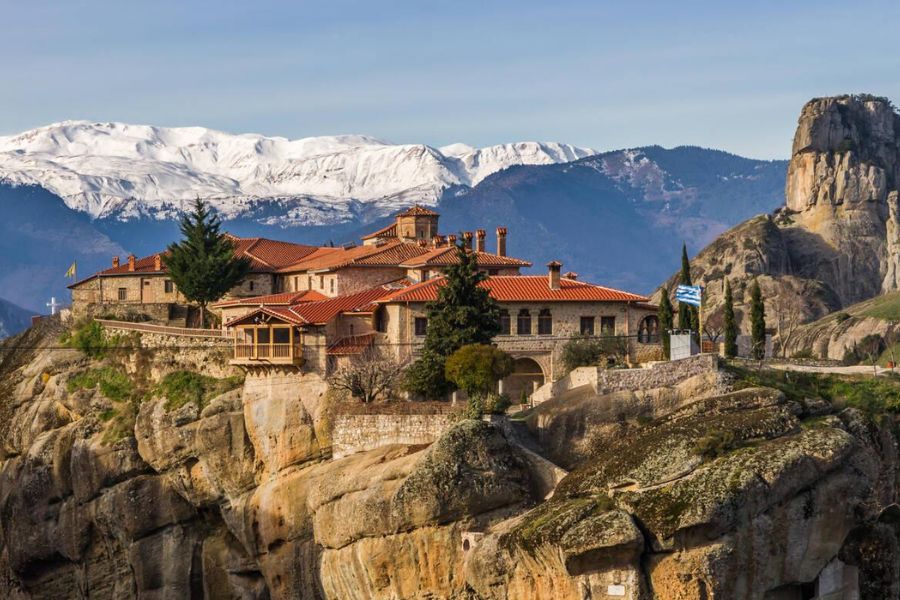
My camera hardly left my hand during my visit, though inside the monasteries, photography isn’t permitted. The views stretch for miles across the surrounding valleys, and each monastery offers a different perspective of this breathtaking landscape. If you’re planning a trip to Greece, add Meteora to your must-see list – it’s a place where nature and human history combine to create something truly magical.
The Majestic Landscape of Meteora
Walking through Meteora feels like stepping into another world where nature and human spirituality blend seamlessly together. The dramatic scenery creates a place of wonder that’s both visually stunning and spiritually moving.
Rock Formations and Natural Beauty
The first time I saw Meteora’s towering rock formations, I literally stopped in my tracks. These massive stone pillars rise dramatically from the Thessalian Plains, creating a landscape that seems almost otherworldly. Some reach heights of over 1,200 feet, their weathered surfaces telling the story of millions of years of geological history.
What makes Meteora truly special is the contrast between these rugged rocks and the lush greenery surrounding them. In spring, wildflowers dot the landscape, while autumn brings rich golden and red hues to the trees. The Pindus Mountain Range provides a stunning backdrop to this natural masterpiece.
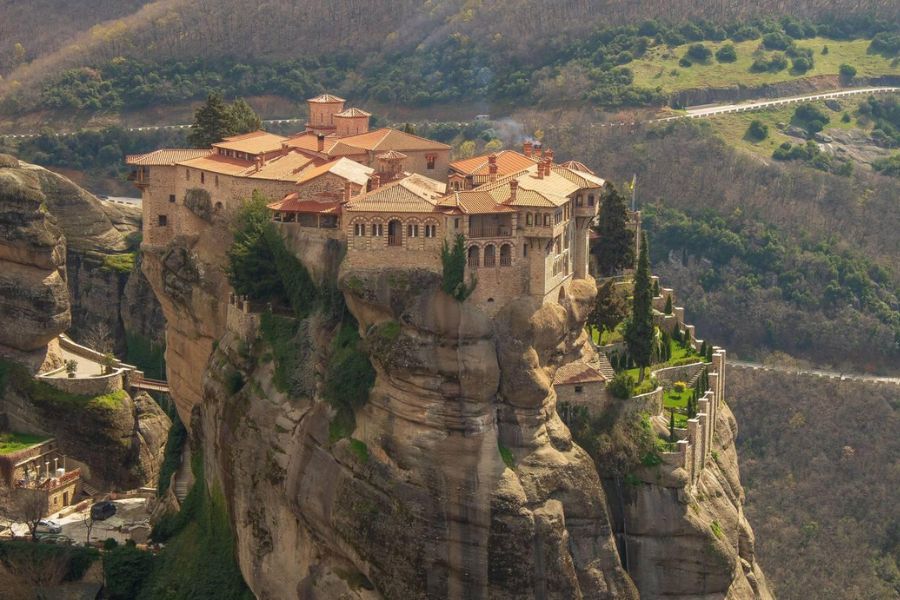
The rocks themselves have fascinating shapes – some appear like giant mushrooms, others like twisted fingers reaching toward the sky. This unique landscape feels like what one search result accurately called an “energy well” – a place where you can connect deeply with nature.
Photography Paradise
Meteora is a dream destination for anyone who loves photography. The changing light throughout the day transforms the landscape completely. Morning fog often wraps around the lower portions of the rocks, creating an ethereal atmosphere where monasteries appear to float above the clouds.
For the best shots, I recommend visiting during the golden hours – early morning or late afternoon when the sunlight bathes the rocks in warm, golden tones. The contrast between the dark monasteries and bright sky creates perfect conditions for fine art photography.
Don’t forget to account for the “bleed area” around your subject when composing shots of the monasteries. This gives your images room to breathe and showcases the dramatic setting. Wide-angle lenses work beautifully here to capture both the monasteries and their precarious perches.
Hiking Adventure to the Monasteries
Hiking in Meteora offers an intimate connection with this remarkable landscape. Well-marked trails wind through forests and along ridges, providing constantly changing views that simply take your breath away.
The paths to the monasteries vary in difficulty. Some are easily accessible with just a short walk, while others require more challenging climbs. The hike up to Great Meteoron, the largest monastery, involves climbing about 300 steps, but the views along the way make every step worthwhile.
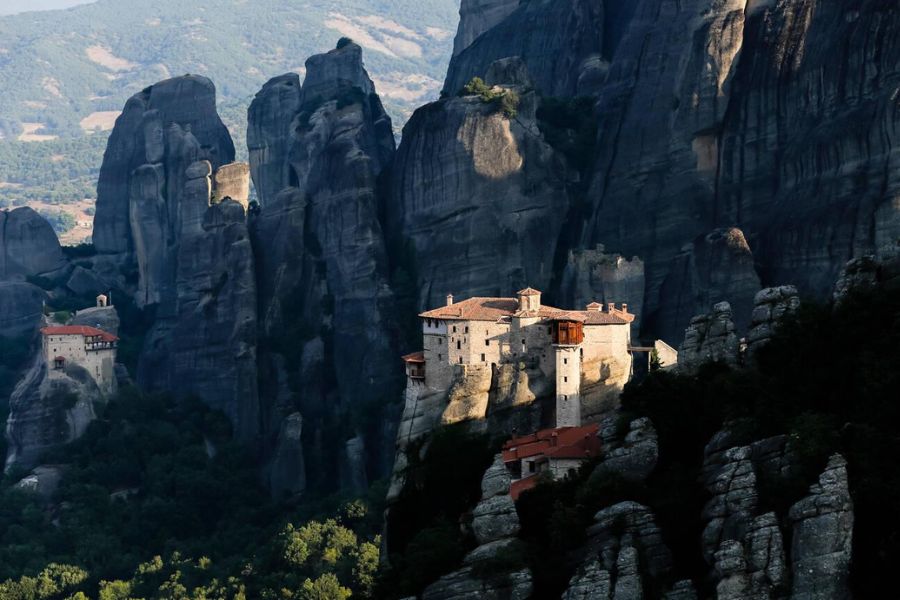
I recommend wearing sturdy shoes and bringing plenty of water, especially during summer months. Start early to avoid both the heat and crowds. The trails offer numerous lookout points where you can pause to appreciate the panoramic views stretching across the Thessalian Plains below.
Historical Significance and Monastic Life
The monasteries perched atop Meteora’s towering rock formations represent centuries of faith, perseverance, and cultural heritage. These sacred spaces have witnessed wars, occupations, and countless prayers while continuing to serve as spiritual beacons.
Founding the Monasteries
The first ascetics arrived in Meteora around the 9th century, seeking solitude in the caves dotting these massive rocks. I was fascinated to learn that formal monastic communities only began emerging in the 14th century, when monks sought refuge from Turkish invasions.
The Great Meteoron, dedicated to the Transfiguration of Christ, was established around 1340 by a monk named Athanasios. His vision transformed these isolated hermitages into a thriving monastic community.
Access to these early monasteries was deliberately challenging. Monks used retractable ladders and rope baskets to reach their sanctuaries. This isolation protected them and ensured only the truly devoted would make the journey.
By the 16th century, 24 monasteries populated these stone pillars, creating a remarkable spiritual landscape unlike anything else in Greece.
Monks and Nuns of Meteora
The daily life of Meteora’s monastics revolves around prayer and work. Walking through the monasteries, I observed how monks and nuns follow traditional Orthodox practices dating back centuries.
Their day typically begins before dawn with morning prayers in the katholikon (main church). Prayer is central to their existence – a means to connect with God and seek blessing.
Most monasteries now house small communities. I spoke with a monk who explained that modern residents continue ancient traditions of icon painting, manuscript copying, and maintaining the grounds.
The nuns particularly impressed me with their textile work, creating intricate embroideries and religious garments. They also produce honey, herbal remedies, and other goods that support their communities.

Many monastics described coming to Meteora because of its spiritual energy and breathtaking beauty, feeling called to this extraordinary landscape for contemplation.
The Monasteries During World War II
During World War II, Meteora’s monasteries faced grave dangers. When Nazi forces occupied Greece in 1941, these sacred sites became targets for looting and destruction.
The monks showed remarkable courage, hiding valuable religious artifacts and manuscripts in remote caves. Some even sheltered resistance fighters and Jewish refugees within monastery walls.
I stood in awe learning about how the Great Meteoron monastery secretly housed important Byzantine treasures throughout the occupation, preserving Greece’s cultural heritage.
The isolated location proved advantageous as some German soldiers were reluctant to climb the precarious paths to reach the monasteries. Local villagers often helped smuggle food to the monks during these difficult years.
After the war, the monasteries slowly recovered, though several remained abandoned until Greece’s tourism boom began bringing pilgrims and visitors back to these sacred heights.
A Traveler’s Guide to Visiting Meteora
My journey to Meteora’s monasteries revealed that proper planning and cultural awareness make all the difference. This mystical destination requires thoughtful preparation, respect for monastic customs, and knowledge of the surrounding towns to fully appreciate its wonder.
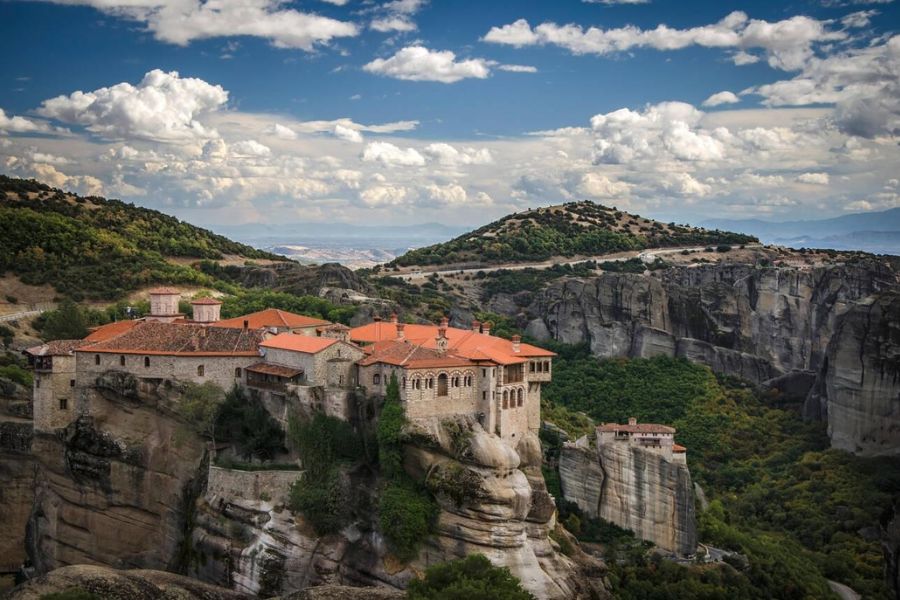
Preparing for Your Pilgrimage
The best time to visit Meteora is during spring (April-June) or fall (September-October) when the weather is pleasant and crowds are thinner. I found that staying at least two full days allowed me to explore most monasteries without rushing.
Getting to Meteora from Athens takes about 4-5 hours by train or car. The train journey offers spectacular views of the Greek countryside and costs around €20-30 one way.
Pack comfortable walking shoes! The steps to reach some monasteries are steep and numerous. I recommend bringing:
- Modest clothing (shoulders and knees covered)
- Water bottle and snacks
- Camera (photography is allowed in designated areas)
- Small backpack for essentials
- Cash for entrance fees (about €3 per monastery

Consider booking a guided tour if you want in-depth historical context. The geological and religious significance becomes much richer with expert insights.
Respecting Monastic Traditions
The monasteries remain active religious sites, not just tourist attractions. Women must wear skirts (wraps are provided at entrances) and men should wear long pants. Both shoulders must be covered.
I learned to speak softly and follow photography rules. Some areas prohibit photos, especially during prayer times. These moments of quiet contemplation became some of my most meaningful memories.
Each monastery has different opening hours and closing days. Most operate from 9am-5pm in summer and 9am-2pm in winter, but they’re closed on different weekdays. I found an updated schedule at the Kalambaka tourist office.
During my visit, I witnessed monks going about their daily routines. Remember that these are their homes—approach with respect and gratitude for their hospitality.
Navigating Kalambaka and Kastraki
Kalambaka serves as the main hub for Meteora visitors, offering numerous hotels, restaurants and shops. I stayed in a family-run guesthouse with monastery views for about €50 per night.
The smaller village of Kastraki sits closer to the monasteries and provides a more authentic, peaceful atmosphere. Its traditional tavernas serve delicious local specialties like wild mushroom soup and lamb dishes.
Public buses run from both towns to the monasteries, but they’re infrequent. I rented a car (€30-40 daily) for flexibility, though hiking trails connect most sites for the adventurous.
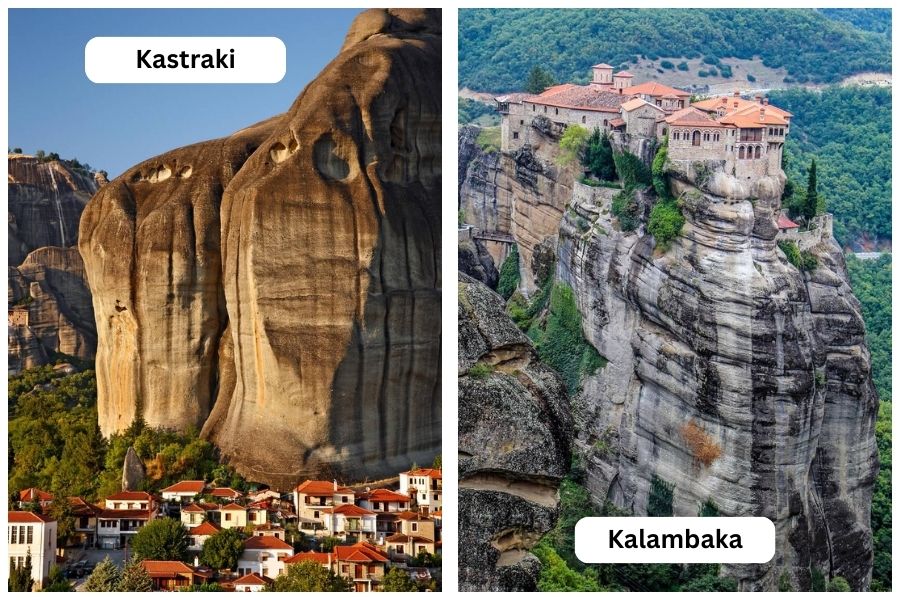
Don’t miss Kalambaka’s Natural History Museum or the Byzantine Church of the Dormition of the Virgin Mary while in town. The evening light creates perfect photo opportunities of the monasteries from town viewpoints.
Art and Architecture of Meteora’s Holy Spaces
The monasteries of Meteora aren’t just spiritual havens – they’re artistic and architectural treasures that have survived centuries. Each monastery combines stunning Byzantine artistry with incredible engineering feats that still puzzle modern architects.
Frescoes and Icons: A Glimpse into Byzantine Artistry
Walking into these monasteries, I was immediately struck by the vibrant frescoes covering nearly every wall. These paintings tell biblical stories and depict saints in the distinctive Byzantine style. The colors remain surprisingly vivid despite being hundreds of years old.
At Varlaam Monastery, I stood mesmerized by the intricate gold-leaf details that make the holy figures seem to glow when sunlight streams through the windows. The icons particularly captivated me – their solemn faces and stylized forms create a sense of timelessness.

Many of the most impressive frescoes date back to the 14th and 16th centuries. Artists used natural pigments that have stood the test of time. The most common themes I noticed were scenes from Christ’s life and portraits of Orthodox saints.
The Architectural Marvel of Cliffside Sanctuaries
The monasteries’ construction seems almost impossible when you see them perched atop massive rock pillars. Builders spent 20-30 years gathering materials using ropes, nets, and pulleys to haul everything up these sheer cliffs.
The Holy Trinity Monastery features 195 steps carved directly into solid rock. I was breathing hard by the time I reached the top, but the view was worth every step. The monasteries blend seamlessly with their natural surroundings, using local stone that makes them appear as extensions of the rock formations.
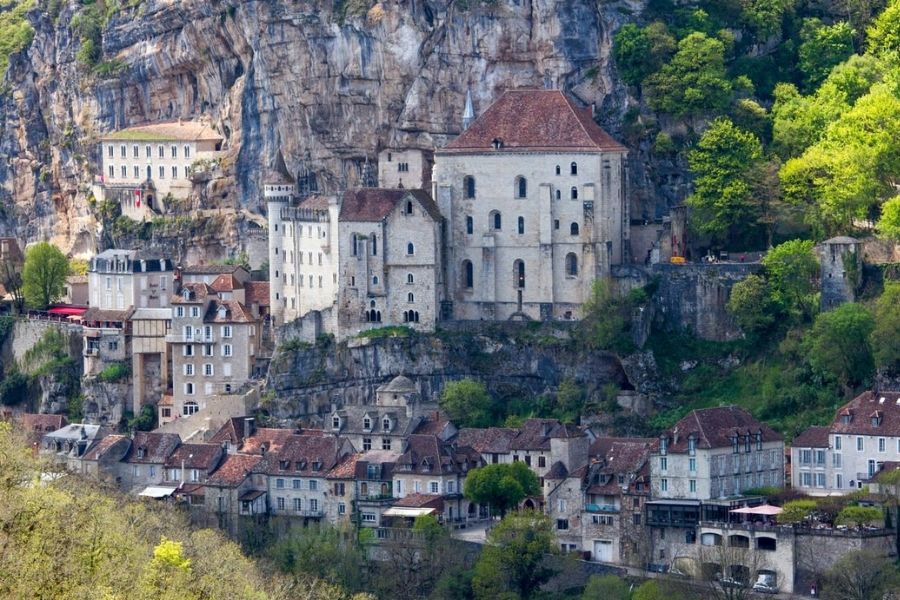
Inside, I found unexpected architectural details: timber-beamed ceilings, clever ventilation systems, and rain collection methods that allowed monks to survive in isolation. The buildings themselves are marvels of medieval engineering.
Preserving Monasterial Manuscripts and Treasures
Each monastery houses a collection of precious manuscripts and religious artifacts. I was fortunate to see some of these treasures during my visit. Many contain ancient texts written in beautiful calligraphy with hand-painted illustrations.
The monasteries function as both museums and living religious sites. Glass cases display centuries-old religious vestments embroidered with gold thread and studded with precious stones. I spotted ornate crosses, chalices, and other ceremonial items still used for special occasions.
The most impressive preservation work happens behind the scenes. Dedicated experts carefully maintain these items in climate-controlled environments. Some manuscripts contain unique historical records and rare religious texts that scholars continue to study today.
Meteora as a Cultural and Spiritual Experience
Visiting Meteora transcends ordinary tourism and becomes a journey into centuries of faith, tradition, and human perseverance. The monasteries perched atop massive rock formations offer a unique blend of cultural heritage and spiritual depth that transforms visitors regardless of their religious background.
Personal Reflections on Tranquility and Faith
Standing on the edge of Meteora’s cliffs, I felt a profound silence that seemed to speak louder than words. The monasteries, built by determined hermit monks seeking isolation, create an atmosphere where even non-religious visitors can feel something spiritual stirring within.
The morning mist that often envelops the rock pillars adds to the mystical quality. I watched as it slowly cleared, revealing the monasteries one by one, like a divine curtain being drawn back.
What struck me most was how the landscape itself seemed to inspire meditation. Many travelers I met at viewing points weren’t taking photos but simply sitting in contemplation, drawn by the unique energy of this UNESCO World Heritage Site.

Time moves differently here. Minutes stretched into meaningful hours as I found myself reflecting on life’s bigger questions, something that rarely happens during typical vacations.
Interacting with the Monastic Community
The monks and nuns of Meteora maintain traditions that have continued uninterrupted for centuries. When visiting, I wore modest clothing. This included long pants and sleeves, out of respect for these living spiritual communities.
Inside each monastery, I observed daily routines that haven’t changed much since medieval times. Monks tended gardens and transcribed ancient texts. They also welcomed pilgrims with a quiet dignity.
One elderly monk at Great Meteoron Monastery spoke limited English. But, he conveyed profound wisdom through simple gestures and warm smiles. He showed me icons being restored using techniques passed down through generations.
Visitors should note that monasteries have different operating hours and days. I found it worthwhile to research this beforehand to maximize my experience with the monastic community.
The silence observed within these sacred spaces isn’t just a rule—it’s part of the experience. Even with other tourists present, a respectful hush pervades these ancient halls.
The Enduring Allure of Meteora’s Heritage
Meteora’s cultural significance extends beyond religion. These monasteries preserved Greek heritage, art, and manuscripts during the Ottoman occupation, becoming beacons of national identity.
The architectural achievement alone is staggering. Built without modern technology, these structures required incredible determination.
Supplies and building materials were originally hauled up using baskets and rope systems. Some monasteries still use updated versions of these systems today.
Inside, breathtaking Byzantine frescoes cover walls and ceilings. The colors remain vibrant despite centuries of candle smoke and changing seasons.
Each painting tells biblical stories and depicts saints important to Orthodox Christianity.
What makes Meteora truly special is how it continues to function as both a living religious community and a cultural landmark.
Unlike many historical sites that feel frozen in time, Meteora pulses with continuing spiritual practice.

The monasteries’ ability to adapt while maintaining tradition ensures their relevance for contemporary pilgrims and curious travelers alike.
This delicate balance is what keeps drawing people from around the world to experience Meteora’s unique heritage.

